Here's a scene to set the collector's heart a flutter!
It's a view of Britain's largest postcard fair, The Festival of Cards, held in Somerset last month. I was in the UK at the time to visit family, so I took the chance to head along to the fair.
After taking the photo, I headed downstairs to the dealers, asking each one in turn, "Do you have anything from Hong Kong?" Most said "No", but sometimes I'd be directed to a box like this.
The hunt is on!
First I'll make a quick pass through the photos, looking for any that:
- Have an interesting story to tell
- Are sharp, with plenty of detail
A good story means I can use the photo in my newsletters, talks, and books. A sharp photo means I'll be able to enlarge it once I've scanned it. That gives me a chance of finding more stories in the hidden details, and also means the photo will enlarge well if I'm selling it as a print. Any postcards or photos that meet these conditions get put on the "Need a closer look" pile.
At one dealer, these four caught my eye.
I haven't seen these scenes before, which is a good start as it means there could be some new stories to explore. Next, although they were sold individually the fact they all have that unusual border with the rounded corners makes me think they all came from the same original source, which is another point in their favour. Finally, they looked to be Real Photo Postcards ("RPPC" in the collector's jargon), so there's a higher chance they are sharp.
Let's flip them over to see if we can get any more clues.
They've never been mailed, so there isn't any postmark to help us with the date, and there aren't any written notes from the original owner. But we can see they are all printed on the same Agfa brand of photographic paper. That confirms they came from the same source - a professional photographer earning some extra money by selling postcard copies of his photos, and that they are indeed Real Photo Postcards.
Onto the "Need a closer look" pile they went, then it was back to the box to work through the rest of this dealer's cards.
Finally it was time for that closer look. I mean that very literally, removing each card from its plastic sleeve and looking at it through my magnifying glass. I was 99% sure the cards are RPPC, and the magnifying glass confirmed it - no sign of the dots we'd see if the card had come from a printing press. Here's what else I could see...
I find I'm often drawn to photos that expand on a theme we've looked at before. Do you remember seeing the photo below on Gwulo? I wrote about it in the newsletter, back in 2017.
It shows a travelling cobbler. We can see the shoulder pole he uses to carry everything he needs to make and mend shoes: a basket full of leather on one end of the pole, and a wooden cabinet with his tools on the other.
The cobbler in the new photo has the same set of equipment, but he also has a wooden bar on the wall where he can hang shoes he is working on. I wonder if he's starting to put down roots at this location, instead of being always on the move?
Under the window there's some writing.
I'll be grateful if readers can help translate the Chinese characters for me, and give any explanation for what they mean. I wondered if they might show the name of the cobbler, marking out this section of the pavement as his regular pitch?
As for the level of detail, I'll say it is good but not great. It looks as though the photographer focused on the characters on the wall, leaving the two men slightly blurred.
This time the photographer's focus is spot on, giving us a clear view of a man who doesn't look to be having the best of days.
I guess he's a hawker, and he looks as though he'd just sold something to the customer wearing the large hat.
The hawker also has very distinctive headgear, what looks like a padded ring. Other photos we've seen of hawkers show them using shoulder poles to carry their equipment from place to place, but there isn't any sign of a shoulder pole here. Instead when this man has finished his work for the day, I think he'd fold up his table, stack up his bowls and baskets, and carry them away on his head. The 'doughnut' would help to make it more comfortable.
- Q1. Have you seen any other Hong Kong photos of people using this type of padded ring, and / or any showing people carrying goods on their heads?
Before moving on to photo 3, we can also identify this photo's location as Causeway Road, the road that gives Causeway Bay its name. Originally the road ran along a narrow causeway that carried it across the shallow bay. The area on the right / inland side of the road was soon reclaimed, but on the left side we see the Causeway Bay Typhoon Shelter, so it was still connected to the sea. That has since been reclaimed too, so today we have Victoria Park on the left, and if you turned to the right you'd see the Central Library.
We haven't got a date yet, but several clues from this photo will help fix that.
Out in the harbour there's a distinctive wooden structure - a square shape with diagonal cross bars. These were built at the start of reclamation projects, showing the position of the future sea wall, and the furthest extent of the reclamation. We can see it's a way out in the harbour, so this will be a big reclamation when it's finished. The likely candidate is the Praya East Reclamation project off Wanchai, that pushed the shoreline north from the Praya East (today's Johnston Road) to the new Gloucester Road.
There is additional confirmation if you look at the shoreline. You can see the darker colour where fresh soil has recently been tipped out, and then a pair of railway lines. They're explained by a photo we looked at in Volume 2 of my books:
It shows men excavating the old Morrison Hill, with the soil running down the slope to fill up the side-tipping carts waiting at the bottom. When all the carts are full a steam engine will tow them along the rails out to the water's edge, where the soil is tipped out into the sea. The rails are easily moved, so whenever the reclamation has moved too far beyond the rails, workers could pick up the rails and carry them to the water's edge. That cycle was repeated over and over until the reclamation was complete.
This reclamation project started in 1921 - though the real work didn't begin until 1922 - and was finished in 1929. I'll date the photo to the second half of the 1920s, say c. 1927. One of the benefits of having photos from the same source is that we can take clues from one and apply it to the whole set, giving us a rough date for all four photos.
- Q2. Do readers have any examples of RPPCs that use this type of Agfa paper and have been mailed, so we can see the postmark? It would be great to see firm examples of this paper being used in the 1920s.
No doughnuts here, they need shoulder poles for their heavy loads.
They are heading inland, so instead of contributing to the reclamation they're delivering something from one of the boats along the water's edge. It looks like building sand to me, which would make sense as there will be a lot of construction work on this new land.
The last photo is a very different scene, the interior of a shop selling all types of ceramic pots and figures. It's the sharpest photo in the set, probably because it was a posed photo, where the photographer could take his time and set up the camera on a tripod.
I don't have a story yet for this one, but I do have a couple of questions:
- Q3. Have you seen any other photographs of this shop? It is such a striking display I wondered if other photographers had captured it, and if they gave any more detail about the shop's location and owners?
- Q4. Expats would likely visit this shop to pick up some reminders of their time in the Far East. If your family members were in Hong Kong during the 1920s, I wonder if you might have one of the items on display here as a family heirloom? (You can zoom in to the photo to see more detail.) If you spot any matches, please could you upload a photo for us to see?
...
These four photos all passed the closer inspection. I paid the dealer and brought them home with me.
More photos and stories
You'll find more photos and stories of The Praya East Reclamation in Volume 1 (photo 19) and Volume 2 (photos 12, 25) of my books, and of shoulder poles in Volume 4 (photos 5-9). The books are available to buy direct from Gwulo, from local bookstores, or via Amazon UK / Amazon US (the links to Amazon are affiliate links).
The Royal Asiatic Society (RAS), Hong Kong
I originally prepared these notes as part of a talk I gave to the RAS last Thursday.
A big thank you to Helen and Vonnie at the RAS for all their help in arranging a very enjoyable evening, and to everyone who attended.
The RAS hosts regular talks and visits on a wide range of topics, and many of them cover Hong Kong's history. You can see the calendar of future events on their website.
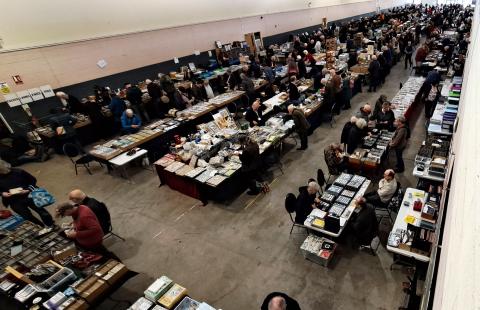
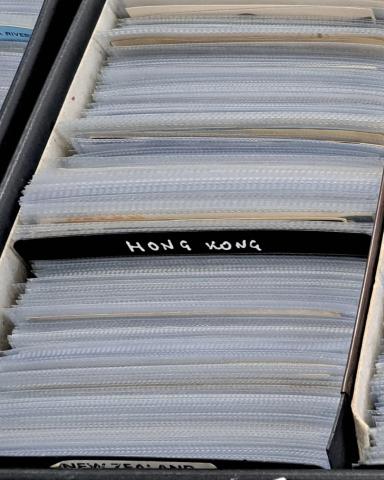
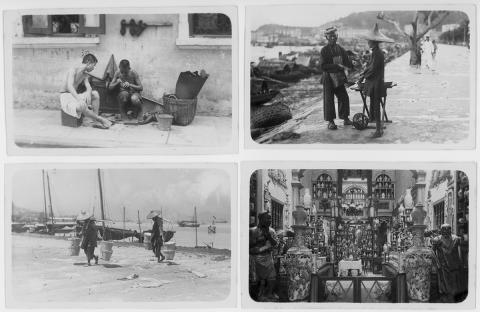
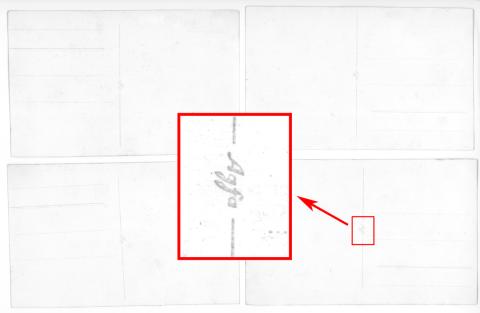
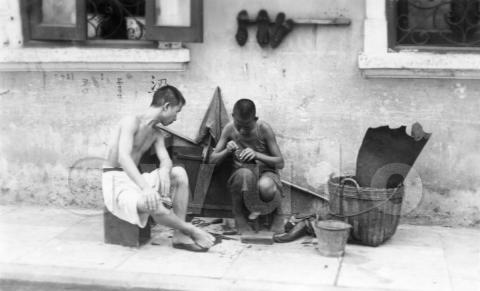
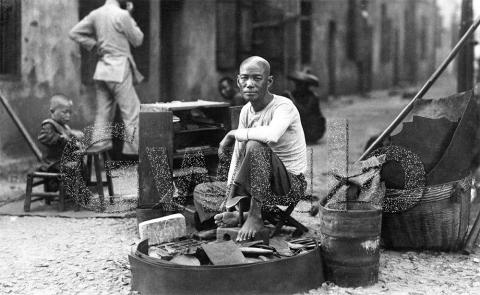

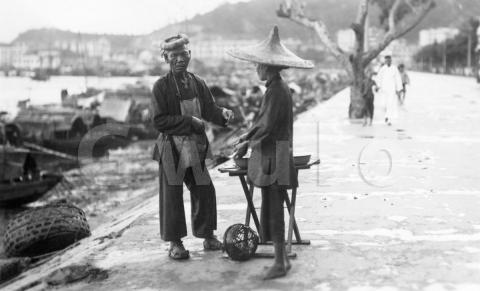
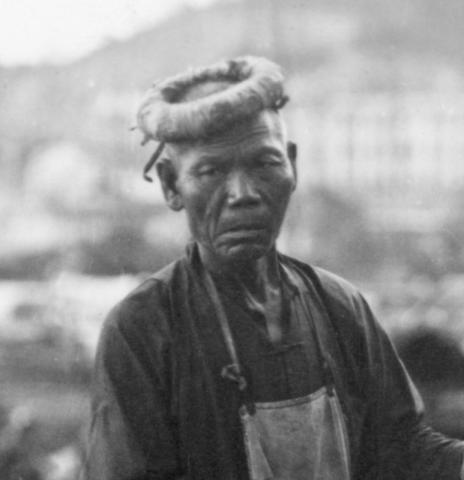
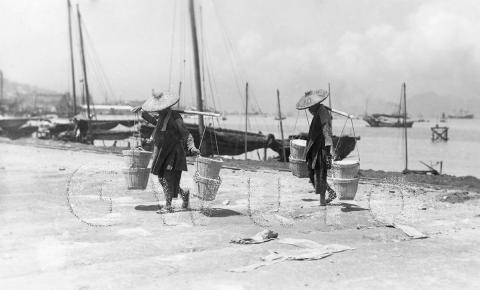

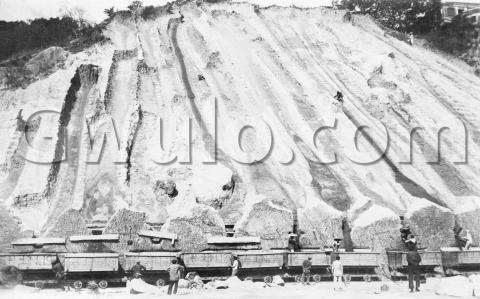

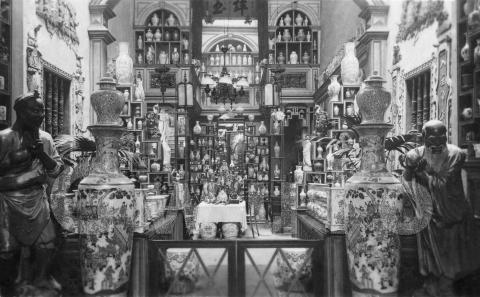
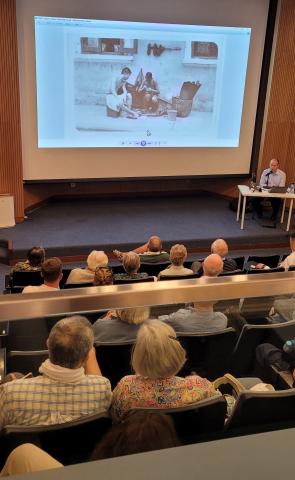
Comments
Under the window there's some writing.
Dear David,
The character directly above the man's head is 梁 leung4, a common surname. Although the other writing is too small to see clearly, the same character seems to appear in some of the other strings of 3-4 characters elsewhere, suggesting they may be personal names. The character at the end of some of the strings may be 住 jyuh = "to dwell". Perhaps the writing is meant to indicate who is living in the building.
Not very helpful. Perhaps someone else can make something more out of it . . .
Warm regards,
Simon
re: Under the window there's some writing.
Thanks Simon. There are some more comments and a sharper copy of the writing at: https://gwulo.com/media/45045
Carrying on the head
Octa wrote in with a comment and a photo: